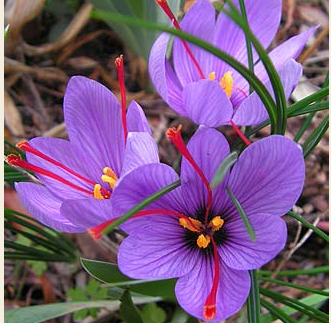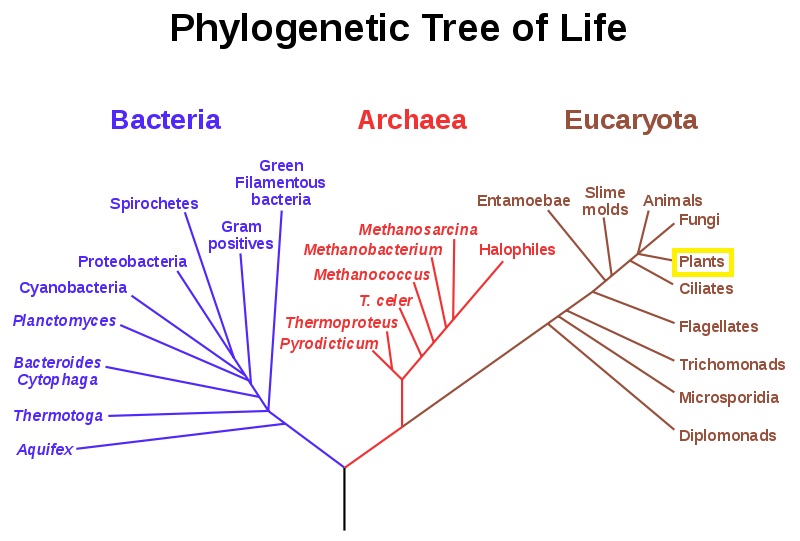Classification:
"Fitting In" to the
Tree of Life
In order to see a more detailed and hand drawn phylogenetic tree of
how saffron fits into the general tree of life that I created
myself, continue to the
following link:
General Phylogenetic Tree.pdf
Domain: Eukarya
These organisms have membrane bound organelles and a nucleus. In addition their cells are about 10 times larger than a prokaryotic cell, have 80S ribosomes and have multiple linear chromosomes. Furthermore, Eukaryotic organisms, unlike organisms within the domains Bacteria and Archae, are able to be multicellular. There are, however, Eukarya that are unicellular. Members of this domain consist of everything from Protists, Fungi like the Wood Ear Fungus, Plants, and Animals such as the Chicken.
Kingdom: Plantae
Therefore this organism, like other plants such as Juniper, Coffee, and Tea Plant, has cell walls made of cellulose, contains a specific membrane bound organelle that is known as a chloroplast that contains the pigment chlorophyll, and thus can carry out photosynthesis. Photosynthesis is the process in which carbon dioxide and water are transformed via sunlight into glucose and oxygen.
Photosynthesis: 6CO2 + 6H2O --> C6H12O6 + 6O2
Phylum: Magnoliophyta (Angiosperm)
Magnoliophyta, or better known as angiosperms, are known as flowering plants. These organisms are the most advanced phylum of all the plants since they are vascular, sporophyte dominant, and most importantly bear fruit. The fruit, which comes from the flower and is made from ovarian tissue, coats and protects the seeds (female gametes). It also allows for more diverse methods of fertilization (i.e. wind, water, animals...). Some other organisms that are classified as angiosperms are the Sweet Orange, the Castor Bean, and the Apple Guava.
Class: Liliopsida (Monocot)
Monocots, unlike dicots, have only one single cotyledon, along with parallel veins within their leaves, petals in multiples of threes, pollen only containing one pore rather than three, and fibrous roots. Other monocots include Wild Yams, Garden Ginger, and Barley.
Order: Asparagales
This order of plants is known to be herbaceous plants that live year-round due to their underground storage organs. They tend to have fleshy or fibrous stems, "strap-shaped" leaves, brightly colored flowers.
Family: Iridaceae
These organisms are known to possess a bulb, rhizome, or corm. In addition this family of plants is a perennial group in which the plant survives for longer than 2 growing seasons, or in other words these plants live throughout the entire year. The saffron plant "dies back" to its bulb structure underneath the ground where it is no longer visible and appears to be dead, but is in actuality, just "hibernating" through the cold seasons. Furthermore, this family is known to have their leaves being equitant, or found within the same plane as the stem.
Genus: Crocus
Plants from this genus are characterized for being flowering perennials that grow from a corm. They tend to grow in the Mediterranean, Southern Europe, the Alps, and Central Asia. Also, these plants can close up their flowers during cold or bad conditions as a method of protection.
Species: C. sativus

This species of crocus flowers is known for its lilac-colored petals, three burnt-orange colored stigmas being the distal ends to the carpel of this plant, growing very low to the ground (about 2 inches tall), and having long and thin leaves that can grow to be about 5-8 inches long. In addition, this particular species is known to contain the carotenoid dye called crocin, which is the reason saffron gives food its signature golden color.
For more information about the adaptations saffron uses in its natural habitat continue to Adaptation/Habitat.
Return to Homepage Go to MultipleOrganisms.net


